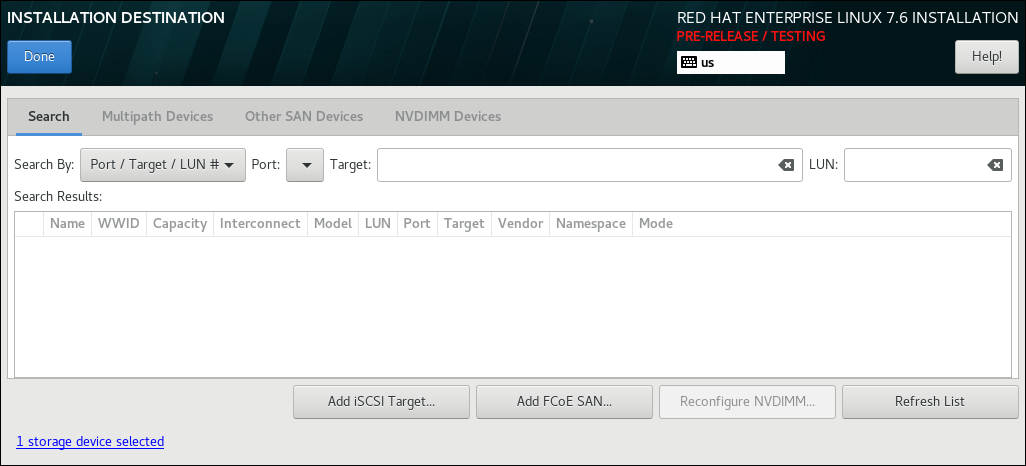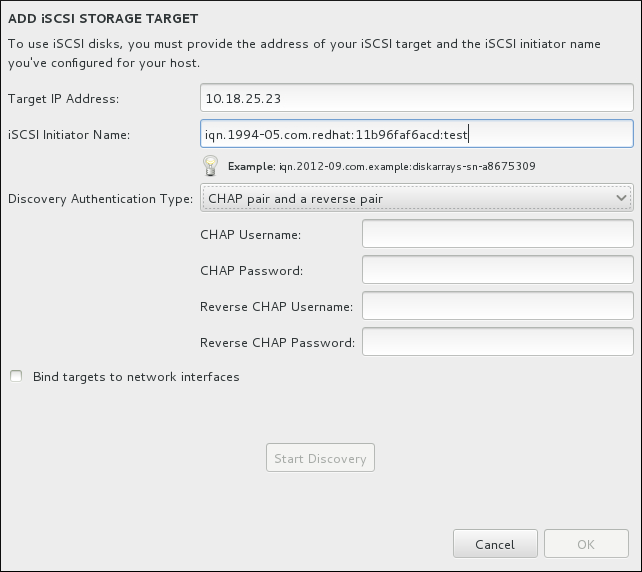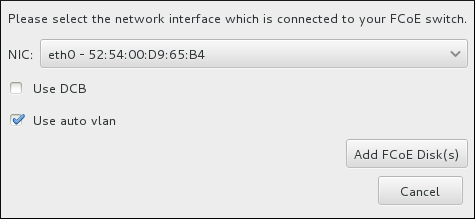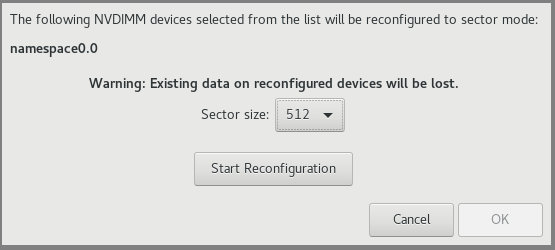8.15. Storage Devices
Figure 8.28. Storage Space Overview
Note
dmeventd daemon is not performed during installation.
8.15.1. The Storage Devices Selection Screen
- Multipath Devices
- Storage devices accessible through more than one path, such as through multiple SCSI controllers or Fiber Channel ports on the same system.The installation program only detects multipath storage devices with serial numbers that are 16 or 32 characters long.
- Other SAN Devices
- Devices available on a Storage Area Network (SAN).
- NVDIMM Devices
- Non-Volatile Dual In-line Memory Module (NVDIMM) storage devices on the machine.
Figure 8.29. Tabbed Overview of Specialized Storage Devices
- - use to attach iSCSI devices; continue with Section 8.15.1.1.1, “Configuring iSCSI Parameters”
- - use to configure a Fibre Channel Over Internet storage device; continue with Section 8.15.1.1.2, “Configuring FCoE Parameters”
- - use to reconfigure a NVDIMM device into sector mode; continue with Section 8.15.1.1.3, “Configuring NVDIMM Devices”
- - use to reload the list when a device is added after the installer starts.
Figure 8.30. The Storage Devices Search Tab
/etc/fstab file.
Important
8.15.1.1. Advanced Storage Options
Figure 8.31. Advanced Storage Options
8.15.1.1.1. Configuring iSCSI Parameters
Figure 8.32. The iSCSI Discovery Details Dialog
Note
Procedure 8.1. iSCSI Discovery and Starting an iSCSI Session
- Enter the IP address of the iSCSI target in the Target IP Address field.
- Provide a name in the iSCSI Initiator Name field for the iSCSI initiator in iSCSI qualified name (IQN) format. A valid IQN entry contains:
- the string
iqn.(note the period) - a date code that specifies the year and month in which your organization's Internet domain or subdomain name was registered, represented as four digits for the year, a dash, and two digits for the month, followed by a period. For example, represent September 2010 as
2010-09. - your organization's Internet domain or subdomain name, presented in reverse order with the top-level domain first. For example, represent the subdomain
storage.example.comascom.example.storage - a colon followed by a string that uniquely identifies this particular iSCSI initiator within your domain or subdomain. For example,
:diskarrays-sn-a8675309
A complete IQN can therefore look as follows:iqn.2010-09.storage.example.com:diskarrays-sn-a8675309. Anaconda prepopulates the iSCSI Initiator Name field with a name in this format to help you with the structure.For more information on IQNs , see 3.2.6. iSCSI Names in RFC 3720 - Internet Small Computer Systems Interface (iSCSI) available from http://tools.ietf.org/html/rfc3720#section-3.2.6 and 1. iSCSI Names and Addresses in RFC 3721 - Internet Small Computer Systems Interface (iSCSI) Naming and Discovery available from http://tools.ietf.org/html/rfc3721#section-1. - Use the Discovery Authentication Type drop-down menu to specify the type of authentication to use for iSCSI discovery. The following options are available:
- no credentials
- CHAP pair
- CHAP pair and a reverse pair
- If you selected as the authentication type, provide the user name and password for the iSCSI target in the CHAP Username and CHAP Password fields.
- If you selected as the authentication type, provide the user name and password for the iSCSI target in the CHAP Username and CHAP Password field and the user name and password for the iSCSI initiator in the Reverse CHAP Username and Reverse CHAP Password fields.
- Optionally check the box labeled Bind targets to network interfaces.
- Click the button. Anaconda attempts to discover an iSCSI target based on the information that you provided. If discovery succeeds, the dialog displays a list of all iSCSI nodes discovered on the target.
- Each node is presented with a check box beside it. Click the check boxes to select the nodes to use for installation.
Figure 8.33. The Dialog of Discovered iSCSI Nodes
- The Node login authentication type menu provides the same options as the Discovery Authentication Type menu described in step 3. However, if you needed credentials for discovery authentication, it is typical to use the same credentials to log into a discovered node. To do that, use the additional option from the menu. When the proper credentials have been provided, the button becomes available.
- Click to initiate an iSCSI session.
8.15.1.1.2. Configuring FCoE Parameters
Figure 8.34. Configure FCoE Parameters
- Use DCB
- Data Center Bridging (DCB) is a set of enhancements to the Ethernet protocols designed to increase the efficiency of Ethernet connections in storage networks and clusters. Enable or disable the installation program's awareness of DCB with the check box in this dialog. This option should only be enabled for network interfaces that require a host-based DCBX client. Configurations on interfaces that implement a hardware DCBX client should leave this check box empty.
- Use auto vlan
- Auto VLAN indicates whether VLAN discovery should be performed. If this box is checked, then the FIP (FCoE Initiation Protocol) VLAN discovery protocol will run on the Ethernet interface once the link configuration has been validated. If they are not already configured, network interfaces for any discovered FCoE VLANs will be automatically created and FCoE instances will be created on the VLAN interfaces. This option is enabled by default.
8.15.1.1.3. Configuring NVDIMM Devices
Figure 8.35. Reconfigure NVDIMM
Warning
Figure 8.36. Successfully reconfigured NVDIMM







